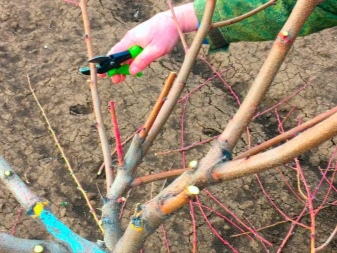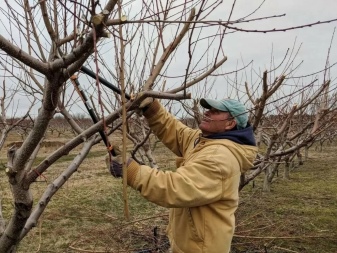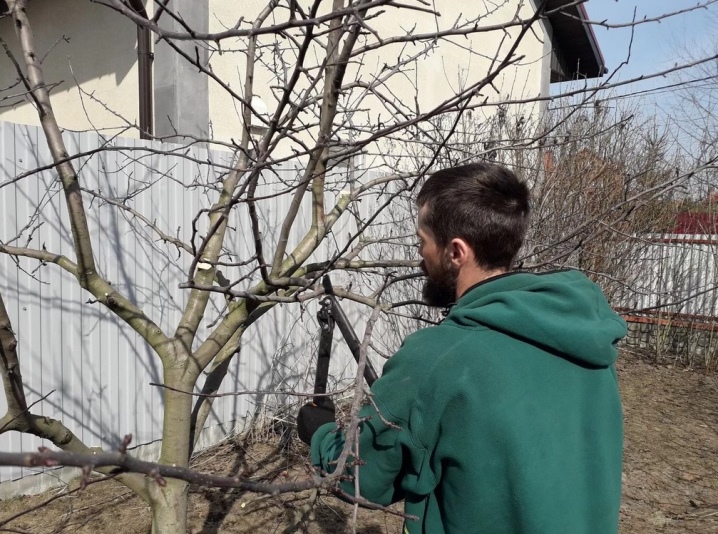Spring peach pruning

Despite the fact that the peach is considered a rather unpretentious crop, it cannot do without regular pruning. The formation of the crown of the tree is carried out depending on the season, as well as the age of the specimen itself.



Timing
Unlike many trees, pruning of a peach in spring is not done before the juices begin to move, but when this process has already begun. Experts call this period the stage of "rosebud", characterized by the proximity of the opening of the swollen buds. In this phase, the state of the tree after wintering is correctly determined, which makes it possible to form an optimal load for the culture, the result of which will be abundant fruiting.

I must say that some gardeners generally risk pruning when the peach is already blooming, but this solution is not considered popular.
The exact dates are determined depending on the weather conditions and, accordingly, the climatic characteristics of a particular region. For example, for the middle zone, including the Moscow region, April is optimal, and in the Crimea and the Kuban, it is allowed to start a wellness procedure in March. The Urals, Siberia, the Leningrad region, that is, regions famous for low temperatures, require the procedure from the second half of April to the beginning of May. In any case, one should also be guided by the state of the tree, trying to catch up with the period from revival, that is, a clear design and swelling of pinkish buds, before flowering. It usually lasts a couple of weeks. Nighttime temperatures during this period should already be stable and not fall below +5 degrees.

If pruning is done very early, the peach tree will not bloom in time. Return frosts and, accordingly, a decrease in temperatures even to -2 will contribute to the death of the opened buds. Late pruning of the crop is also not suitable - in this case, the crop is either heavily delayed or does not ripen at all. It is important to remember: if the procedure is not organized in a timely manner and too many fruits have time to set on the tree, ripe peaches are likely to turn out small, since the plant does not have enough strength to "feed" them all.
The flavor characteristics of the fruit will also deteriorate. In addition, the more ovaries there are on a tree and the more shoots sprout every year, the worse the culture's immunity becomes, since the lion's share of the energy is spent on the development of unnecessary parts.

Required tools
To remove excess tree branches, the usual tools available in the gardener's arsenal are suitable. For young and thin shoots, the thickness of which does not exceed 4 centimeters, an ordinary pruner is suitable, and to eliminate thicker branches, a special hacksaw is required. Burrs on wood can be easily cut off with a garden knife. If you plan to form the crown of an adult peach, then you can get to the most inaccessible parts using a ladder and a pruner with long handles.





All devices must be disinfected. For example, for this purpose it is proposed to use "Formayod", 50 milliliters of which are diluted with 5 liters of water, or a solution of five percent copper sulfate. A basic drug such as a one percent solution of potassium permanganate is also suitable. The instruments are soaked in liquid for a couple of minutes, after which they are dried dry with a clean cloth or napkin.In addition, it is important that all cutting parts are sharp and allow straight cuts.


Dull inventory will create lacerations on the surface of the peach that will take a long time to heal.
Of course, work cannot be started without preparing the garden varnish, the substances with which the cut points will be smeared, and the brush with which it will be applied. In principle, if the resulting wound has a small diameter, it is allowed to simply treat it with a 2% solution of copper sulfate.


Technology for trees of different ages
The rules for carrying out the shaping procedure largely depend on the age of the peach tree, which should be remembered for novice gardeners.

Young
Spring pruning of young trees is mainly aimed at crown formation. It depends on which skeletal and semi-skeletal shoots remain with an annual tree, how it can develop further, how strong it will become and what kind of harvest it will give. It must be said that shortening is usually carried out when planting a seedling, and when the culture reaches 1 year. Spring pruning of a young tree can be accompanied by a couple of summer procedures if the peach is actively giving new branches. The formation of the crown is carried out in such a way as to obtain a "cup" that does not interfere with the emergence and growth of new branches, as well as simplifies the process of collecting fruits.

This is all done according to a simple scheme. If the peach has no lateral branches, then the seedling itself is shortened to 50–70 centimeters a couple of days after planting. Starting next spring, the central conductor has to be cut to a length of 50 centimeters. Usually this size is considered optimal for growing a peach tree in a well-lit area. Further, from the strongest shoots, one skeletal branch is selected, growing at an angle of 45-60 degrees in relation to the trunk. Finally, another similar shoot is determined in a mirror to it - it is they who will form the skeleton of the seedling.

Some gardeners, however, leave 3-4 branches on the tree and shorten them over 2-3 buds. The rest of the shoots are cut completely to the point of growth.
I must say that in the case of a juvenile peach, it is allowed to choose between "bowl" and "improved bowl". In the first case, shoots growing at an angle emanate practically from one point, and in the second, there can be a gap of 15–20 centimeters in height between them. The resulting crown provides the culture with the necessary aeration and receives sufficient illumination. As a result, fruits ripen faster, their taste becomes sweeter, and the lack of thickening prevents the spread of insects and diseases. As a rule, it takes 3-4 years to form a crown, therefore, at the age of 2 and 3 years, the procedure must be repeated, but with minor changes.
For example, after the second "birthday", when a one-year increment has already formed on the skeletal branches, it will have to be shortened. A couple of shoots with a 30-40 cm gap between them will be cut by almost a third, and the rest of the growth will be completely eliminated. A year later, branches of the third order are already processed, leaving 4–5 copies on each semi-skeleton. The formed bowl should have a maximum of 4 skeletal shoots in the lower tier, 2-3 semi-skeletal shoots on each, and approximately 4-5 branches of the third order.

Fruiting
Fruiting peach trees should be properly pruned in such a way as to make the crown less thickened, remove "empty" shoots that consume nutrient resources, and, accordingly, stimulate fruiting. We must not forget that sanitization enhances the culture's resistance to diseases and pests. In the spring of mature trees, dried and broken branches are necessarily removed, as well as those on which traces of the vital activity of parasites or disease are visible.
In addition, those shoots that grow inside the crown, fatty "tops" - located almost vertically and incapable of fruiting or being too close to each other and, as a result, provoking thickening, will have to be cut off. It would be correct to get rid of branches that were frozen out during the winter, strongly curved, heading down and forming an acute angle of less than 45 degrees.


The procedure ends with the harvesting of root shoots and young shoots that have grown under the first skeletal branch.
Old
Pruning old trees is aimed at rejuvenating the peach, and therefore is carried out at the moment when the specimen stops developing and delight with a bountiful harvest. The need for such a procedure is determined depending on the state of the tree. For example, this may be signaled by crumbling ovaries, decreasing harvest volumes, or slowed growth of new shoots, which is less than 25-30 centimeters. The rejuvenating procedure is carried out every 3-4 years, and the first is carried out 7-8 years after the first fruiting, and the last - no later than the fifteenth year after planting in the ground.


If the specimen being processed is very old and neglected, then the crown has to be formed in several approaches, stretching for 2–4 years. All shoots older than 5 years are subject to removal. It is worth mentioning that an adult peach - upon reaching the age of nine - may undergo detailed pruning. In this case, more than half of the branches are removed altogether, and the other half is trimmed. Differential pruning, arranged between the fifth and eighth years of the life of the peach tree, is also suitable for the plant.

Its essence lies in thinning the upper part of the crown and shortening the lower one.
Follow-up care
After removing excess branches, the cuts must be processed with garden varnish, paint based on vegetable drying oil or brilliant green. Large wounds are covered completely, but if their diameter does not exceed 3-4 centimeters, then it will be enough to process only the edges. Such a procedure prevents the occurrence of putrefactive processes, protects open surfaces from moisture, and also prevents the spread of bacteria and fungal spores. In addition, the first week after pruning, the gardener is advised to carefully monitor the condition of the peach and, if necessary, repeat the treatment with garden var.









The comment was sent successfully.